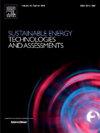考虑加压管道系统中弹性水锤效应的抽水蓄能装置稳定性能:机理分析和定量标准
IF 7.1
2区 工程技术
Q1 ENERGY & FUELS
Sustainable Energy Technologies and Assessments
Pub Date : 2024-11-25
DOI:10.1016/j.seta.2024.104105
引用次数: 0
摘要
加压管道系统中水柱的流动特性对抽水蓄能电站(PSPS)的稳定性有很大影响。然而,由于弹性水柱的数学表达较为复杂,在稳定性分析中往往将其简化为刚性水柱。本研究分别基于弹性水柱和刚性水柱建立了 PSPS 系统的弹性模型和刚性模型。确定并比较了这两个模型的调速器参数稳定区域。结果表明,弹性模型的稳定区域小于刚性模型。因此,使用简化的刚性模型来评估实际弹性系统的稳定性会带来潜在的不稳定性风险。此外,造成弹性模型和刚性模型稳定性差异的主要原因是水锤波速。随着波速的增加,弹性模型的稳定区域也随之扩大,最终接近刚性模型的稳定区域。最后,阐明了加压管道与抽水蓄能装置之间的耦合机制。提出了水锤反射系数模量来量化抽水蓄能装置的稳定性能。这些发现为确保 PSPS 的稳定运行提供了重要的启示。本文章由计算机程序翻译,如有差异,请以英文原文为准。
Stability performance of pumped-storage units considering elastic water hammer effects in pressurized piping systems: Mechanism analysis and quantitative criterion
The flow characteristics of water columns in pressurized piping systems significantly influence the stability of pumped-storage power stations (PSPSs). However, the complex mathematical representation of the elastic water column often leads to its simplification to a rigid column in stability analyses. This study established elastic and rigid models of a PSPS system based on elastic and rigid water columns, respectively. The stability regions of the governor parameters for these two models were determined and compared. Results indicate that the stability region of the elastic model is smaller than that of the rigid model. Consequently, using a simplified rigid model to evaluate the stability of an actual elastic system would pose potential instability risks. Furthermore, the primary cause of the stability difference between the elastic and rigid models is identified as the water hammer wave velocity. As the wave velocity increases, the stability region of the elastic model expands, eventually approaching that of the rigid model. Lastly, the coupling mechanism between the pressurized pipe and the pumped-storage unit is clarified. The modulus of the water hammer reflection coefficient is proposed to quantify the stability performance of the pumped-storage unit. These findings provide crucial insights for ensuring the stable operation of PSPSs.
求助全文
通过发布文献求助,成功后即可免费获取论文全文。
去求助
来源期刊

Sustainable Energy Technologies and Assessments
Energy-Renewable Energy, Sustainability and the Environment
CiteScore
12.70
自引率
12.50%
发文量
1091
期刊介绍:
Encouraging a transition to a sustainable energy future is imperative for our world. Technologies that enable this shift in various sectors like transportation, heating, and power systems are of utmost importance. Sustainable Energy Technologies and Assessments welcomes papers focusing on a range of aspects and levels of technological advancements in energy generation and utilization. The aim is to reduce the negative environmental impact associated with energy production and consumption, spanning from laboratory experiments to real-world applications in the commercial sector.
 求助内容:
求助内容: 应助结果提醒方式:
应助结果提醒方式:


